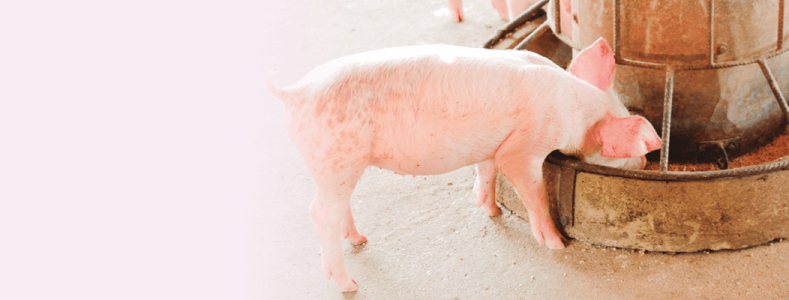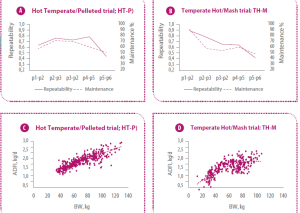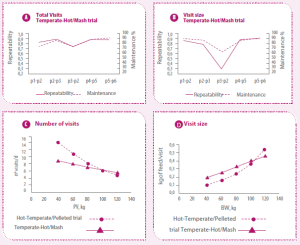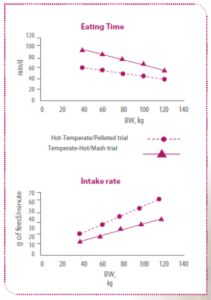![]() number of daily visits to the feeder (number of visits/day),
number of daily visits to the feeder (number of visits/day),
 15 May 2023
15 May 2023
Feeding behavior in grow-finishing pigs and how it is influenced by environmental conditions and feed presentation.
During the grow-finishing phase there is high variability in the productive results of individual pigs; which penalizes the yield of the lot (López-Vergé et al., 2018).
One of the factors that influences such individual variability due to its influence on nutrient digestibility is feeding behavior habits(Lu et al., 2017; Jia et al., 2021).
Feeding behavior habits(FBHs) in grow-fattening pigs are defined as the distribution of daily feed intake in terms of:
![]() number of daily visits to the feeder (number of visits/day),
number of daily visits to the feeder (number of visits/day),
![]() daily eating time (minutes/day),
daily eating time (minutes/day),
![]() meal size per visit to the feeder(grams of feed/visit) and,
meal size per visit to the feeder(grams of feed/visit) and,
![]() rate of intake (grams of feed / minute), etc.
rate of intake (grams of feed / minute), etc.
According to the number and size of visits to the feeder, we can observer and determine two types of pigs: those whose daily intake consists of multiple small visits to the feeder, referred to as “pecks”; and those pigs that complete their daily intake with a few large meals, also known as “gluttons” (Fernández et al., 2011; Garrido-Izard et al., 2020).
![]() Regardless of the number and size of meals, there are also pigs that have higher intake rates. Which may be referred to as “fast eating”, or “slow eating” when that intake rate is slower.
Regardless of the number and size of meals, there are also pigs that have higher intake rates. Which may be referred to as “fast eating”, or “slow eating” when that intake rate is slower.
In order to answer this question, it is necessary to know if pigs maintain the same feeding behavior throughout the complete duration of their grow-finishing stage.
![]() If this is case, we can analyze the influence of FBH on production yields and carcass quality. As well as employing it as a prediction and selection criterion.
If this is case, we can analyze the influence of FBH on production yields and carcass quality. As well as employing it as a prediction and selection criterion.
Repeatability results range from 0 to 1. That is, from an unpredictable parameter (0) to one that can be reliably predicted (1).
A low repeatability value may be due to the fact that most of the animals within a group have low repeatability values or because a small number of pigs within that group have extremely low values. Which will penalize the overall result of that group of pigs.
Due to a previously observed high variability in terms of FBH within the same group of grow-finishing pigs (Carcò et al., 2018), this article aims to presents new calculations to determine repeatability at an individual level.
This new calculation is referred to as “maintenance”,and it is defined as:
The percentage of pigs within a group that exhibit similar FBH during consecutive periods.
Some of the results shown below, belong to a recent study carried out by Fornós et al. (2022). FBH was determined together with its repeatability and maintenance during 6 consecutive 14 day periods (p) in two tests. Each test was carried out with 60 grow-finishing pigs(from 16.5 to 114.6 kg of live weight, BW).
![]()
In both tests, pigs were housed in groups and fed ad libitum with an automatic hopper in each pen; which recorded duration, amount of feed consumed and the BW of the pig for each visit to the feeder.
1. The first test started in summer and ended in autumn, and the pigs were fed with granulated feed (Hot Temperate/Pelleted trial; HT-P) 

Although the effects of environmental conditions and feed presentation on FBH could not be separated, both external factors influenced feeding behavior.

In both tests, the average daily feed intake (ADFI) exhibited the lowest repeatability and maintenance variables from all FBH parameters. With only 50% of pigs maintaining their ADFI at the end of the fattening stage (Figures 1A-B). This result corresponds with the repeatability values obtained by De Haer and Merk (1992) and Hyun et al. (1997).
![]()
On the other hand, up to 70 kg of BW, ADFI increased in both tests. However, from 70 kg BW in the HT/P test the ADFI continued to increase, while in the TH/M test it stabilized due to environmental conditions (Figures 1C-D).
 This result confirms that the effects of heat stress on consumption are greater at older ages. Exhibiting a significant reduction in intake levels(Baumgard and Rhoads, 2013; da Fonseca de Oliveira et al., 2018).
This result confirms that the effects of heat stress on consumption are greater at older ages. Exhibiting a significant reduction in intake levels(Baumgard and Rhoads, 2013; da Fonseca de Oliveira et al., 2018).
In summary, as pigs grow, the predictability of ADFI becomes more complicated, regardless of the environmental conditions and feed presentation. However, from 70 kg BW heat stress significantly penalizes ADFI in pigs.

Figure 1. Repeatability and maintenance of the average daily feed intake (ADFI) of the Hot-Temperate/Pelleted trial (A) and duration each (p1-p6), together with the evolution of the Temperate-Hot/Mash trial (B) from period 1 to period 6 with 14 days of ADFI in both tests (C and D).
![]()
The number and size of visits, time spent eating and pace of intake presented high repeatability (> 0.7) and maintenance (> 70%) values, except when environmental conditions changed from thermoneutrality to heat stress; at which point the repeatability and maintenance of the number and size of visits was reduced (p3 to p4, Figures 2A-B).
This change in FBH was maintained as long as there was heat stress (p3 to p6, Figures 2A-B). In fact, the results suggest that under heat stress the pigs were able to maintain their ADFI up to 70 kg of BW. This was associated with a greater number of visits to the feeder and a reduction in meal size (Figures 2C-D) in an attempt to reduce excessive body heat increases after intake (Cervantes et al., 2018).
Meanwhile, at older ages, the number of visits to the feeder was not modified, but it the meal size was reduced. Which affected overall ADFI(Figures 2C-D).

Figure 2. Repeatability and maintenance of the number of visits (A) and the visit size (B) together with the evolution of the number of visits (C) and the visit size (D) of the Hot-Temperate/Pelleted trial and Temperate-Hot/Mash trial.

The evolution of eating time and rhythm of intake was parallel between tests (Figure 3). However, regardless of the environmental conditions, meal-fed pigs spent more time eating due to their lower intake rate compared to the granule-fed pigs. This result coincides with those obtained by Laiat et al. (2004) and Li et al. (2017).

Figure 3. Evolution of eating time(minutes/day) and intake rate(g of feed/minute) for the Hot-Temperate/Pelleted trial and the Temperate-Hot/Mash trial.
Both parameters, repeatability and maintenance, provide complementary and consistent information. In fact, during this study we observed a period for which maintenance provided significant information.
Thus, from 70 kg of BW under thermoneutral conditions and with granule feeding, the repeatability of eating time and intake rate in pigs decreased (< 0.70). However, maintenance values were high (> 80%).
This behavior suggests that only about 10-20% of the pigs did not maintain their FBH, penalizing the group’s repeatability values and, consequently, the yield of the lot.
 The main contribution of the maintenance parameter is that it provides information at the individual level. This makes it an interesting tool to be applied in production or animal welfare, where it is especially important evaluate pigs on an individual basis. In addition to this, and with genetic selection at hand, it is worth determining if FBHs can be inherited.
The main contribution of the maintenance parameter is that it provides information at the individual level. This makes it an interesting tool to be applied in production or animal welfare, where it is especially important evaluate pigs on an individual basis. In addition to this, and with genetic selection at hand, it is worth determining if FBHs can be inherited.
![]() Feeding behavior habits of finishing-growing pigs depend on the presentation of feed and their environmental conditions. As there was evidence of a clear influence of environmental conditions on the number and size of feeding visits. The presentation of the feed also influenced eating time time and the rhythm of intake of the pigs being studied.
Feeding behavior habits of finishing-growing pigs depend on the presentation of feed and their environmental conditions. As there was evidence of a clear influence of environmental conditions on the number and size of feeding visits. The presentation of the feed also influenced eating time time and the rhythm of intake of the pigs being studied.
![]() On the other hand, except for their average daily intake, pigs maintained their feeding behavior during the finishing stage under constant environmental conditions. Hence, it is possible to correlate eating behavior with productive results.
On the other hand, except for their average daily intake, pigs maintained their feeding behavior during the finishing stage under constant environmental conditions. Hence, it is possible to correlate eating behavior with productive results.
Source: This article was originally published as a Spanish content in NutriNews Spain March 2023
Subscribe now to the technical magazine of animal nutrition
AUTHORS

Hybrid Rye Potential in Laying Hen Feed Rations
Gwendolyn Jones
A day in the life of phosphorus in pigs: Part I
Rafael Duran Giménez-Rico
Use of enzymes in diets for ruminants
Braulio de la Calle Campos
Minerals and Hoof Health in the Pregnant Sow
Juan Gabriel Espino
Impact of Oxidized Fats on Swine Reproduction and Offspring
Maria Alejandra Perez Alvarado